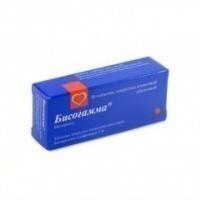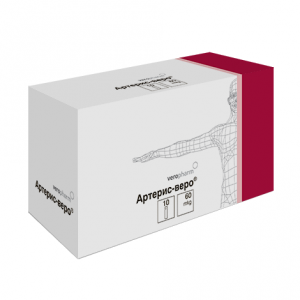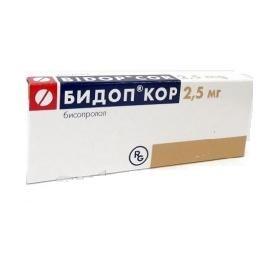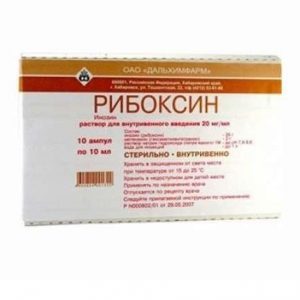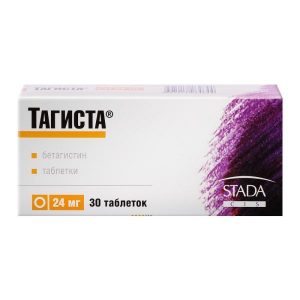Description
Latin name
Bisogamma
Release form
Film-coated tablets.
Packing
30 pcs 5 mg each.
Pharmacological action
Selective beta1-blocker without internal sympathomimetic activity, does not have a membrane-stabilizing effect. Reduces blood plasma renin activity, reduces myocardial oxygen demand, reduces heart rate (at rest and during exercise).
It has hypotensive, antiarrhythmic and antianginal effects. Blocking in low doses 1-adrenergic receptors of the heart, reduces catecholamine-stimulated cAMP production from ATP, reduces the intracellular current of calcium ions, has a negative chrono-, dromo-, batmo- and inotropic effect.
With an increase in the dose above the therapeutic, it has a beta2-blocking effect.
At the beginning of drug administration, in the first 24 hours, OPSS increases (as a result of reciprocal increase in alpha-adrenergic receptor activity and elimination of stimulation of 2-adrenergic receptors) and after 1-3 days it returns to the original, and decreases with prolonged use.
The antihypertensive effect is associated with a decrease in minute blood volume, sympathetic stimulation of peripheral vessels, a decrease in the activity of the renin-angiotensin system (of great importance for patients with initial hypersecretion of renin), restoration of sensitivity in response to a decrease in blood pressure and effects on the central nervous system.
With arterial hypertension, the effect occurs after 2-5 days, a stable effect – after 1-2 months.
The antianginal effect is due to a decrease in myocardial oxygen demand as a result of decreased heart rate and reduced contractility, lengthening of diastole, and improved myocardial perfusion. By increasing the final diastolic pressure in the left ventricle and increasing the stretching of the muscle fibers of the ventricles, it can increase the need for oxygen, especially in patients with chronic heart failure.
Antiarrhythmic effect due to the elimination of arrhythmogenic factors (tachycardia, increased activity of the sympathetic nervous system, increased content of cAMP, arterial hypertension), a decrease in the rate of spontaneous excitation of sinus and ectopic pacemakers and a slowdown in AV conduction (mainly in the antegrade and, to a lesser extent, retrograde directions through the AV node) and along additional paths.
When used in medium therapeutic doses, unlike non-selective beta-blockers, Bisogamma ® has a less pronounced effect on organs containing 2-adrenergic receptors (pancreas, skeletal muscle, smooth muscles of the peripheral arteries, bronchi and uterus) and on carbohydrate metabolism , does not cause a delay of sodium ions in the body according to the severity of the atherogenic effect does not differ from propranolol.
Indications
Arterial hypertension.
ischemic heart disease: prevention of angina attacks.
Contraindications
Shock (including cardiogenic).
Collapse.
Pulmonary edema.
Acute heart failure.
Chronic heart failure in the decompensation stage.
AV block II and III degree.
Sinoatrial blockade.
SSSU.
Severe bradycardia.
Angina pectoris.
Cardiomegaly (without signs of heart failure).
Arterial hypotension (systolic pressure <100 mmHg, especially with myocardial infarction). Severe forms of bronchial asthma and other obstructive airways diseases. Late stages of peripheral circulation disturbance, Raynaud’s disease. Pheochromocytoma (without the simultaneous use of alpha-blockers). metabolic acidosis. Depression. Concurrent administration of MAO inhibitors (except for type B MAO inhibitors). Children and adolescents under 18 years of age. Hypersensitivity to the drug and other beta-blockers. Caution: the drug should be prescribed to patients with liver failure, chronic renal failure, myasthenia gravis, thyrotoxicosis, diabetes mellitus, first-degree AV blockade, psoriasis with a history of depression, allergic reactions in elderly patients. Use during pregnancy and lactation Prescribing during pregnancy and lactation is only possible if the intended benefit to the mother outweighs the potential risk to the fetus or infant. Composition 1 tablet contains: Active ingredient: bisoprolol hemifumarate – 5 mg. Excipients: crospovidone, pregelatinized starch, microcrystalline cellulose, silicon dioxide colloidal, magnesium stearate, macrogol 6000, polysorbate 20, titanium dioxide (E171), calcium carbonate (E170), talc, dye iron (III17 HPM yellow oxide) yellow oxide 5), hypromellose (HPMC 50). Dosage and administration The drug is administered orally at a dose of 5 mg 1 time / day, in the morning, on an empty stomach. If necessary, increase the dose to 10 mg 1 time / day. The maximum dose is 20 mg / day. For elderly patients: dose adjustment not required. In patients with impaired renal function with CC <20 ml / min or with severe impaired liver function: the maximum daily dose is 10 mg. Tablets are taken without chewing. Side effects of the From the central nervous system and peripheral nervous system: fatigue, weakness, dizziness, headache, sleep disorders, depression, anxiety, confusion or short-term memory loss, hallucinations, asthenia, myasthenia gravis, paresthesia in the extremities (in patients with intermittent claudication and Raynaud’s syndrome), tremor, convulsions. From the sensory organs: impaired vision, decreased secretion of lacrimal fluid, dry and sore eyes, conjunctivitis. From the cardiovascular system: sinus bradycardia, palpitations, impaired myocardial conduction, AV block (up to the development of complete lateral blockade and cardiac arrest), weakening of myocardial contractility, development (aggravation) of chronic heart failure (ankle swelling, stop shortness of breath), decreased blood pressure, orthostatic hypotension, the manifestation of angiospasm (increased disturbance of peripheral circulation, cooling of the lower extremities, Raynaud’s syndrome), chest pain. From the digestive system: dry mucous membranes of the oral cavity, nausea, vomiting, abdominal pain, constipation or diarrhea, impaired liver function (dark urine, yellowness of the sclera or skin, cholestasis), changes in the activity of liver enzymes (increased ALT, ACT) and bilirubin levels, taste changes. From the respiratory system: nasal congestion, difficulty breathing when prescribed in high doses (loss of selectivity) and / or in predisposed patients – laryngo- and bronchospasm. From the endocrine system: hyperglycemia (in patients with non-insulin-dependent diabetes mellitus), hypoglycemia (in patients receiving insulin), hypothyroid state. From the hemopoietic system: thrombocytopenia (unusual bleeding and hemorrhage), agranulocytosis, leukopenia. From the musculoskeletal system: back pain, arthralgia, cramps in the calf muscles. From the reproductive system: weakening libido, decreased potency. Allergic reactions: skin itch, rash, urticaria. Dermatological reactions: increased sweating, skin hyperemia, exanthema, psoriasis-like skin reactions, exacerbation of psoriasis symptoms, alopecia. Effect on the fetus: intrauterine growth retardation, hypoglycemia, bradycardia. Other: withdrawal syndrome (increased angina attacks, increased blood pressure), increased triglycerides. Drug Interaction Allergens used for immunotherapy or allergen extracts for skin tests increase the risk of severe systemic allergic reactions or anaphylaxis in patients receiving bisoprolol. Iodine-containing X-ray contrast drugs for I / O administration increase the risk of anaphylactic reactions in patients, receiving bisoprolol. Phenytoin with / in administration, medications for inhalation general anesthesia (hydrocarbon derivatives) increase the severity of cardio-depressive action and the likelihood of reducing blood pressure in patients receiving bisoprolol. Bisoprolol alters the effectiveness of insulin and oral hypoglycemic drugs, masking symptoms of developing hypoglycemia (tachycardia, increased blood pressure). Bisoprolol decreases the clearance of lidocaine and xanthines (except for dipyllin) and increases their plasma concentrations, especially in patients with initially increased theophylline clearance under the influence of smoking. The hypotensive effect of bisoprolol is reduced by NSAIDs (retention of sodium ions and blockade of prostaglandin synthesis by the kidneys), GCS and estrogens (retention of sodium ions). Cardiac glycosides, methyldopa, reserpine and guanfacin, slow calcium channel blockers (verapamil, diltiazem), amiodarone, and other antiarrhythmic agents, when co-administered with bisoprolol, increase the risk of developing or worsening bradycardia, AV blockade, cardiac arrest, and heart failure. A significant decrease in blood pressure may occur when used with nifedipine. When used with bisoprolol, diuretics, clonidine, sympatholytics, hydralazine and other antihypertensive drugs can lead to an excessive decrease in blood pressure. Bisoprolol prolongs the action of non-depolarizing muscle relaxants and the anticoagulant effect of coumarins. Tri- and tetracyclic antidepressants, antipsychotic drugs (neuroleptics), ethanol, sedatives and sleeping pills increase the depressant effect of bisoprolol on the CNS. Concomitant use with MAOI inhibitors is not recommended due to a significant increase in antihypertensive activity, with a break of at least 14 days between taking MAOIs and bisoprolol. Non-hydrogenated ergot alkaloids (including ergotamine) when used with bisoprolol increase the risk of peripheral circulation disorders. Sulfasalazine increases the concentration of bisoprolol in blood plasma. Rifampicin decreases T1 / 2 of bisoprolol. Overdose Symptoms: ventricular extrasystole, severe bradycardia, AV blockade, severe BP, chronic heart failure, finger or palm cyanosis, shortness of breath, bronchospasm, dizziness, fainting, convulsions. Treatment: gastric lavage and the appointment of adsorbing drugs. Carrying out symptomatic therapy: at the developed AV blockade – in / in introduction of 1-2 mg of atropine, epinephrine or staging of a temporary pacemaker with ventricular extrasystole – lidocaine (class IA drugs are not used). At decrease in blood pressure the patient should be in the position of Trendelenburg if there are no signs of pulmonary edema – in / in plasma replacement solutions, with inefficiency – the introduction of epinephrine, dopamine, dobutamine (to maintain chronotropic and inotropic action and eliminate pronounced decrease in blood pressure), diuretics, glucagon in convulsions – in / in diazepam with bronchospasm – beta2-adreno-stimulators inhalation. Storage conditions Keep out of the reach of children at a temperature not exceeding 25 ° C. The Expiration of is 3 years. Deystvuyuschee substances bisoprolol dosage form dosage form tablets S.K. Master K and K S.R.L., Germany
